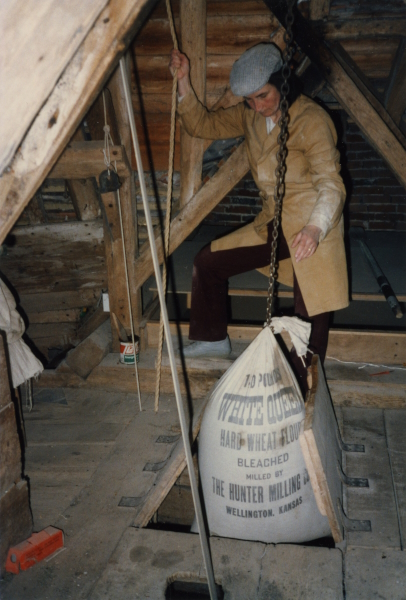 |
| Continuing our story of packaging flour in the US (see our previous blog), we move on from wooden barrels to cloth and paper being used. |
 |
| In developing a suitable change in the packaging, thought had not only to be given to what material to use, but also to the machinery needed to fill them. Other food manufacturers were making rapid advances in packaging to sell their products in efficient and attractive ways.When the decline of the wooden flour barrel set in, jute and cotton bags rapidly took their place. Bags made from these materials were already in use for other industries and they adapted well as flour containers. Once again machinery had to be invented to clean the flour sacks (see advert, above). Packaging advanced as did everything else in the production of flour, and this contributed to the successful merchandising of the product. Cloth bags were ideal to be reused widely by the family for clothing. Many adverts of the time showed children and adults wearing clothes from the bags. |
 |
| Later, paper bags appeared, but even as their use increased, the size of the flour unit decreased; nevertheless, cotton and jute at this time in 1934 were still by far the most widely used for flour.American wheat imported into the UK sometimes came over in jute sacks and I myself would re-use them in the mill. With an abundant supply of cotton and the fact that they suited the purpose of a flour sack, it seemed only natural that these would have a widespread use. |
 |
| Mildred at work hoisting sacks at Mapledurham Mill near Reading, 1986 – MCFC-1122134-04 |
| They were economical, and could be re-used. The stage was reached whereby the filling and closing of the sacks had been brought almost to an exact science. Improved printing processes meant that several colours could be printed on them with inks that would, after many washes, remove all trace, so adding to the sacks reuse value.During the Depression many families used cotton flour bags and feed sacks to make not only clothes, but curtains and other household items including nappies. Once the manufacturers cottoned on to this they began decorating them. The Percy Kent Bag Company even hired top textile designers from Europe and New York City to create stylish prints. |
 |
| In 1927 three yards of printed cotton percale could cost 60 cents in the shop, and three yards of gingham 40 cents. In comparison, three yards of gingham, used in the Gingham Girl Flour sacks, from the George P. Milling Plant Company, would make a dress from two or three 100lb. flour bags. The flour bags were free, but required a lot of baking! These new cotton flour bags could be displayed on the retail shop shelves helping to promote each particular brand of flour. |
 |
| Moving on to paper bags, it was thought that this was first used by grocery stores, who formed ordinary paper into the shape of a bag and tied it together at the top. The next step appeared to be an envelope type of bag which was glued against the leakage of flour or other powdery products. After this came the ‘satchel bottom’ which not only provided a tight container, but could be made to stand alone within a display. It was easily filled with a machine for this purpose and as the surface was smooth it made a better surface for the advertising of the product.The most difficult problem was the type of paper to be used for flour. It has to be light and yet strong. The size also played an important part, bakers still however, required the larger sacks, but the average household demanded a smaller size. This of course had an impact on the mill’s production line. Filling and handling of the new sizes had to be sought. Nowadays this has been perfected regardless of size of bag so from the start of the operation to the finished closed bags, all can be carried on conveyers to any point in the mill.The adverts and images show how the marketing of the larger sacks was aimed at the customer, and one firm, Bemis, ran a series of adverts showing the strength of their bags, using their ‘cat in the bag’ symbol. |
 |







